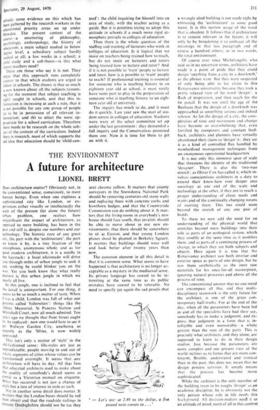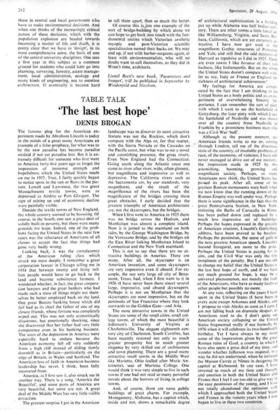THE ENVIRONMENT
A future for architecture
LIONEL BRETT
Does architecture matter? Obviously not, in the conventional sense, consciously, to most human beings. Even when one explores a sophisticated city like London, or ex- periences either visually or intellectually the scale of the present (let alone the future) urban problem, one realises how insignificant the impact of architecture, as opposed to mere building, has been in the past and still is, despite our numbers and our technology. The historic core of any great city, the part with the 'architecture', the part we know it by, is a tiny fraction of the amorphous, anonymous whole, and as for good modern architecture, it is a needle in the haystack: a local aficionado will drive you through miles of urban jungle to seek it out, wishing he could blinker you on the way. Yet you both know that what really matters is this urban jungle in which we nearly all live.
In this jungle, one is inclined to feel that the detail is unimportant. For one thing, it seems to be so much a matter of taste. When I was a child, London was full of what our parents called 'hideosities': things like the Albert Memorial. St Pancras Station and Whitehall Court, now all much admired. Ten Years ago we thought that Pont Street ought to be replaced : now one would hate to see it 10. Welwyn Garden City, anathema as recently as the 'fifties, is now widely approved.
This isn't only a matter of 'style' in the old-fashioned sense: life-styles are just as unpredictable. people moving in and out of whole segments of cities whose values can be transformed overnight. It seems that any architecture will have its day. All that fuss that educated architects used to make about the quality of somebody's detail seems as comic as a Victorian manual on etiquette. What has occurred is not just a chanee of Style but a loss of interest in style as such.
Yet in another sense detail does matter. It matters that the London buses should be red (not silver) and that the roadside railings in remote Denbighshire should not be (as they are) chrome yellow. It matters that county surveyors in the Snowdonia National Park should be removing centuries-old stone walls and replacing them with concrete curbs and hawthorn hedges, and that the Countryside Commission can do nothing about it. It mat- ters that the living-room in everybody's new house should face south, that invalids should be able to move about in our new en- vironments, that there should be somewhere to sit at Euston. and that young London planes shout be planted in Berkeley Square. It matters that buildings should wear well and look better after twenty years than new.
The common element in all this detail is that it is common sense. What seems to have happened is that architecture is no longer ac- ceptable as a mystery in the mediaeval sense. Its private language has ceased to be in- teresting at the same time as its public mistakes have ceased to be tolerable. No need to specify yet again the sad proofs that
— Let's see: at 2.40 to the dollar, a five pound note conies to ...'
a wrongly sited building is not made right by entrusting the 'architecture' to some good name. It is this narrow usage of the word that is obsolete. It follows that if architecture is to remain relevant in the future, it will only be by broadening it to embrace all the meanings in that last paragraph and of course a hundred others; or in two words, the total environment.
Of course ever since Michelangelo. who said so in no uncertain terms, architects have made it a point of pride that they could design 'anything from a city to a doorknob,' as the phrase went. But they were suspected of only being able to lay claim to this Renaissance universality because they took a pretty relaxed view of the word 'design': a flash of inspiration, and then reach for the 6B pencil. It was not until the age of the Bauhaus that the design of a doorknob was approached as something serious and indeed solemn. As for the design of a city, the com- plexities of time and movement and change have become so overwhelming that, even fortified by computers and constant feed- back, architects and planners have virtually abandoned their claim to 'design' it : they see it as a kind of controlled flux handled by standardised management techniques from an anonymous operational headquarters.
It is not only this immense span of scale that threatens the identity of the traditional 'designer'. There is also the 'two-way stretch'. as Oliver Cox has called it, which in- volves conscientious architects in a duty to extend their know-how ever deeper into sociology at one end of the scale and technology at the other, if they are to reach a proper understanding of client needs and wants and of the continually changing means of meeting them. This too could seem beyond the stretch of any one pair of hands.
To these we now add the need for an understanding of the physical world that stretches beyond mere buildings into their role as parts of an ecological system, which they modify at the same time as it modifies them, and as parts of a continuing process of change, in which they are both subjects and objects. Here again it is true that the Renaissance architect saw both interior and exterior space as parts of one design, but he saw them aesthetically as the inert raw materials for his once-for-all masterpiece, ignoring natural processes and above all the process of time.
The conventional answer that no one mind can encompass all this, and that multi- disciplinary teamwork is the only future for the architect, is one of the great con- temporary half-truths. For at the end of the day, when all the parameters have been fed in and all the specialists have had their say, somebody has to make a judgment, and ex- press that judgment in a form that is in- telligible and even memorable—a whole greater than the sum of the parts. This is precisely what architects, and they alone, are supposed to learn to do in their design studios. Just because the parameters arc more complex and our present view of the world inclines us to forms that are more con- tingent, flexible, understated and' ironical than in the past, this does not mean that no design process survives. It simply means that the process has become more sophisticated.
While the architect is the only member of the building team to be taught 'design' as an academic discipline, he is obviously not the only person whose role in life needs this background. All decision-makers need it as an attitude of mind, most of all in this context
those in central and local government who have to make environmental decisions. And when one thinks of the increasingly critical nature of these decisions, which with the population explosion are headed towards becoming a matter of life and death, it is pretty clear that we have in 'design', in its most comprehensive sense, the basis of one of the central university disciplines. One sees a first year in this subject as a common ground for students who could later go into planning, surveying, forestry, estate manage- ment, local administration, ecology and many kinds of engineering, not to mention architecture. If eventually it became hard
to tell them apart, then so much the better.
Of course this is...just one example of the sort of bridge-building by which alone we can hope to get back into touch with the fun- damental unities which Victorian aesthetic myopia and post-Victorian scientific specialisation turned their backs on. We may end up, if not with barber-surgeons again, at least with environmentalists, who will no doubt want to call themselves, as they did in Wren's time, architects.
Lionel Breit's new book, 'Parameters and Images', will be published in September by Weidenfeld and Nicolson.































 Previous page
Previous page